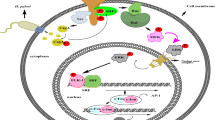Abstract
Helicobacter pylori can efficiently capture iron either from free heme or heme-containing compounds in the iron-limited gastric mucosa. However, the heme iron utilization systems of H. pylori have not been fully described to date. To investigate the contribution of genes involved in heme–iron utilization, a gene homologous to frpB, encode by hp0876 in H. pylori ATCC 26695, was inactivated by homologous recombination. Δhp0876 showed no demonstrable growth defects in the presence of the various concentrations of free iron. Moreover, when hemoglobin or heme was supplied as the sole iron sources, Δhp0876 had growth curves similar to the wild-type strain. The growth competition experiments in vitro also showed that Δhp0876 retained the ability for iron acquisition. Furthermore, IL-8 production in human gastric epithelial cells co-cultured with Δhp0876 and wild-type strain was compared, and our results indicated that lack of HP0876 affected the IL-8 release. And Δhp0876 exhibited significantly increased adherence to gastric epithelial cells. Together, our data suggests that HP0876 is dispensable for H. pylori heme–iron uptake, but it may attenuate H. pylori adherence to gastric epithelial cells, which induced decreased production of H. pylori-induced IL-8 production in gastric epithelial cells.






Similar content being viewed by others
References
Argent RH, Hale JL, El-Omar EM, Atherton JC (2008) Differences in Helicobacter pylori CagA tyrosine phosphorylation motif patterns between Western and East Asian strains, and influences on interleukin-8 secretion. J Med Microbiol 57:1062–1067
Brickman TJ, Vanderpool CK, Armstrong SK (2006) Heme transport contributes to in vivo fitness of Bordetella pertussis during primary infection in mice. Infect Immun 74:1741–1744
Buettner FF, Bendalla IM, Bosse JT et al (2009) Analysis of the Actinobacillus pleuropneumoniae HlyX (FNR) regulon and identification of iron-regulated protein B as an essential virulence factor. Proteomics 9:2383–2398
Gonzalez-Lopez MA, Olivares-Trejo JJ (2009) The gene frpB2 of Helicobacter pylori encodes an hemoglobin-binding protein involved in iron acquisition. Biometals 22(6):889–894
Guo G, Tong WD, Zeng H, Liu KY, Zou QM (2007) Comparative proteomics analysis of Helicobacter pylori after adaptive colonization in Mongolian gerbils. Wei Sheng Wu Xue Bao 47:461–464
Guo Y, Guo G, Mao X et al (2008) Functional identification of HugZ, a heme oxygenase from Helicobacter pylori. BMC Microbiol 8:226
Heuermann D, Haas R (1998) A stable shuttle vector system for efficient genetic complementation of Helicobacter pylori strains by transformation and conjugation. Mol Gen Genet 257:519–528
Hu Y, Jiang F, Guo Y et al (2010) Crystal structure of HugZ, a novel heme oxygenase from Helicobacter pylori. J Biol Chem 286(2):1537–1544
Kortekaas J, Muller SA, Ringler P et al (2006) Immunogenicity and structural characterisation of an in vitro folded meningococcal siderophore receptor (FrpB, FetA). Microbes Infect 8:2145–2153
Kortekaas J, Pettersson A, van der Biezen J et al (2007) Shielding of immunogenic domains in Neisseria meningitidis FrpB (FetA) by the major variable region. Vaccine 25:72–84
Kwok T, Backert S, Schwarz H, Berger J, Meyer TF (2002) Specific entry of Helicobacter pylori into cultured gastric epithelial cells via a zipper-like mechanism. Infect Immun 70:2108–2120
Merrell DS, Thompson LJ, Kim CC, Mitchell H, Tompkins LS, Lee A, Falkow S (2003) Growth phase-dependent response of Helicobacter pylori to iron starvation. Infect Immun 71:6510–6525
Ruggiero P (2010) Helicobacter Pylori and inflammation. Curr Pharm Des 16(38):4225–4236
Schauer K, Gouget B, Carriere M, Labigne A, de Reuse H (2007) Novel nickel transport mechanism across the bacterial outer membrane energized by the TonB/ExbB/ExbD machinery. Mol Microbiol 63:1054–1068
Senkovich O, Ceaser S, McGee DJ, Testerman TL (2010) Unique host iron utilization mechanisms of Helicobacter pylori revealed with iron-deficient chemically defined media. Infect Immun 78:1841–1849
Tomb JF, White O, Kerlavage AR et al (1997) The complete genome sequence of the gastric pathogen Helicobacter pylori. Nature 388:539–547
Velayudhan J, Hughes NJ, McColm AA, Bagshaw J, Clayton CL, Andrews SC, Kelly DJ (2000) Iron acquisition and virulence in Helicobacter pylori: a major role for FeoB, a high-affinity ferrous iron transporter. Mol Microbiol 37:274–286
Waidner B, Greiner S, Odenbreit S et al (2002) Essential role of ferritin Pfr in Helicobacter pylori iron metabolism and gastric colonization. Infect Immun 70:3923–3929
Worst DJ, Otto BR, de Graaff J (1995) Iron-repressible outer membrane proteins of Helicobacter pylori involved in heme uptake. Infect Immun 63:4161–4165
Worst DJ, Maaskant J, Vandenbroucke-Grauls CM, Kusters JG (1999) Multiple haem-utilization loci in Helicobacter pylori. Microbiology 145(Pt 3):681–688
Worst DJ, Sparrius M, Kuipers EJ, Kusters JG, de Graaff J (1996) Human serum antibody response against iron-repressible outer membrane proteins of Helicobacter pylori. FEMS Microbiol Lett 144:29–32
Yamaoka Y, Ojo O, Fujimoto S et al (2006) Helicobacter pylori outer membrane proteins and gastroduodenal disease. Gut 55:775–781
Yokota S, Konno M, Mino E, Sato K, Takahashi M, Fujii N (2008) Enhanced Fe ion-uptake activity in Helicobacter pylori strains isolated from patients with iron-deficiency anemia. Clin Infect Dis 46:e31–e33
Zeng H, Guo G, Mao XH, Tong WD, Zou QM (2008) Proteomic insights into Helicobacter pylori coccoid forms under oxidative stress. Curr Microbiol 57:281–286
Zhang ZW, Dorrell N, Wren BW, Farthingt MJ (2002) Helicobacter pylori adherence to gastric epithelial cells: a role for non-adhesin virulence genes. J Med Microbiol 51:495–502
Acknowledgments
This work was supported by National Natural Science Foundation of China (31170059).
Conflict of interest
The authors report no conflicts of interest.
Author information
Authors and Affiliations
Corresponding author
Rights and permissions
About this article
Cite this article
Liu, T., Shi, Y., Liu, Xf. et al. Helicobacter pylori HP0876 is Dispensable for Heme–Iron Acquisition but Attenuates Bacterial Adherence to Gastric Epithelial Cells. Curr Microbiol 65, 254–261 (2012). https://doi.org/10.1007/s00284-012-0153-0
Received:
Accepted:
Published:
Issue Date:
DOI: https://doi.org/10.1007/s00284-012-0153-0




